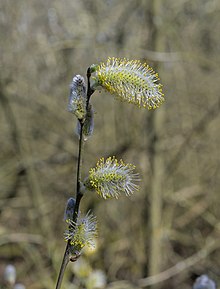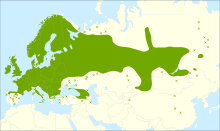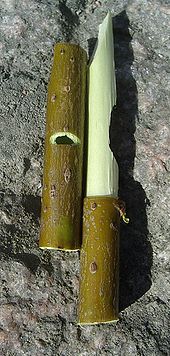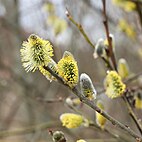Salix caprea
| Salix caprea | |
|---|---|

| |
| Goat willow male catkins | |
| Scientific classification | |
| Kingdom: | Plantae |
| Clade: | Tracheophytes |
| Clade: | Angiosperms |
| Clade: | Eudicots |
| Clade: | Rosids |
| Order: | Malpighiales |
| Family: | Salicaceae |
| Genus: | Salix |
| Species: | S. caprea
|
| Binomial name | |
| Salix caprea | |

| |
| Distribution map | |
| Synonyms[2] | |
|
List
| |
Salix caprea,known asgoat willow,pussy willoworgreat sallow,is a common species ofwillownative toEuropeand western and centralAsia.[3]
Description[edit]
It is adeciduousshrubor smalltree,reaching a height of 8–10 m (26–33 ft), rarely to 13 m.
Theleavesare 3–12 cm long and from 2–8 cm wide, broader than most other willows.
Theflowersare soft silky, and silvery 3-7-cm-longcatkinsare produced in early spring before the new leaves appear; the male and female catkins are on different plants (dioecious). The male catkins mature yellow atpollenrelease, the female catkins mature pale green.
Thefruitis a smallcapsule5–10 mm long containing numerous minuteseedsembedded in fine, cottony hairs. The seeds are very small (about 0.2 mm) with the fine hairs aiding dispersal; they require baresoiltogerminate.[3][4]
- S. c.var.caprea- lowland regions throughout the range, leaves thinly hairy above, densely hairy below, 5–12 cm long, stipules persistent until autumn
- S. c.var.sphacelata(Sm.) Wahlenb. (syn.S. capreavar.coaetaneaHartm.;S. coaetanea(Hartm.) Floderus) - high altitudes in the mountains of central and northern Europe (Alps, Carpathians, Scotland, Scandinavia), leaves densely silky-hairy on both sides, 3–7 cm long, stipules early deciduous. In western Norway there are trees of S. c. var 'Sphacelata' that are 18–20 meters tall and have mostly single trunks.
Name[edit]
The Latinspecific epithetcapreameans "goat".[5]This, and the common name goat willow, probably derive from the first known illustration of the species inHieronymus Bock's 1546Herbal,where the plant is shown being browsed by a goat. The species was historically also widely used as a browse for goats, to which Bock's illustration may refer.[6]
Ecology[edit]
S. capreaoccurs both in wet/damp environments, such as riverbanks and lake shores, and in drier sites, wherever bare soil becomes available due to ground disturbance.[3]
Hybridswith several other willow species are common, notably withSalix cinerea(S. × reichardtii),Salix aurita(S. × multinervis),Salix viminalis(S. × smithiana), andSalix purpurea(S. × sordida). Populations ofS. capreaoften showhybrid introgression.[3][4]
Unlike almost all other willows, pure specimens do not take root readily from cuttings; if a willow resembling the species does root easily, it is probably a hybrid with another species of willow.[4]
The leaves are used as a food resource by several species of Lepidoptera, and are also commonly eaten by browsingmammals.Willows are very susceptible to gall inducers, and the midgeRhabdophaga rosariaforms the camellia gall onS. caprea.[7]
Cultivation and uses[edit]

A small number ofcultivarshave been selected for garden use. The most common isS. caprea'Kilmarnock', discovered byJames Smith,with stiffly pendulous shoots forming a mop-head; it is a male clone. A similar female clone isS. caprea'Weeping Sally'. As they do not form a leader, they aregraftedon erect stems of other willows; the height of these cultivars is determined by the height at which the graft is made.[4]Plants can also be grown from greenwood cuttings, which make attractive creeping mounds. Hardwood cuttings are often difficult to root.
Bothtanninandsalicincan be extracted from goat willow bark. The tree is not considered a good source oftimber,as its wood is both brittle and known to crackle violently if burned.
As with the closely relatedSalix discolor(American pussy willow), it is also often grown for cut flowers. SeePussy willowfor further cultural information, which applies to both species.
In Scandinavia it has been fairly common to makewillow flutesfrom goat willow cuttings.
InGermany,Hungary,north ofSlovakia,PolandandUkraine,the just-opened catkins are used like the olive branches onPalm Sunday.
References[edit]
- ^Barstow, M., Matchutadze, I. & Harvey-Brown, Y. (2018)."Salix caprea".IUCN Red List of Threatened Species.2018:e.T19620273A19621176.doi:10.2305/IUCN.UK.2018-1.RLTS.T19620273A19621176.en.Retrieved11 April2024.
{{cite journal}}:CS1 maint: multiple names: authors list (link) - ^"Salix caprea L.".Plants of the World Online.Board of Trustees of the Royal Botanic Gardens, Kew. 2017.Retrieved7 September2020.
- ^abcdeMeikle, R. D. (1984).Willows and Poplars of Great Britain and Ireland.BSBI Handbook 4.ISBN0-901158-07-0.
- ^abcdRushforth, K. (1999).Trees of Britain and Europe.Collins.ISBN0-00-220013-9.
- ^Harrison, Lorraine (2012).RHS Latin for Gardeners.United Kingdom: Mitchell Beazley.ISBN978-1845337315.
- ^Bean, W. J. (1980).Trees and Shrubs Hardy in the British Isles.ISBN0-7195-2428-8.
- ^Gall InducersArchivedJune 11, 2011, at theWayback Machine
External links[edit]
- Salix caprea- genetic conservation unitsEuropean Forest Genetic Resources Programme(EUFORGEN)
- "Salix caprea".Plants for a Future.
- "Salix bakko".Plants for a Future.



